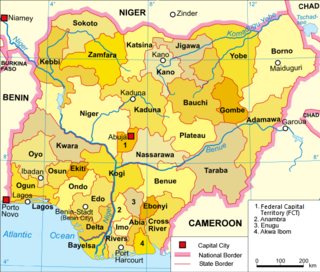Nigeria is located in western Africa on the Gulf of Guinea and has a total area of 923,768 km2 (356,669 sq mi),[47]making it the world's 32nd-largest country (after Tanzania). It is comparable in size to Venezuela, and is about twice the size of California. It shares a 4,047 kilometres (2,515 mi) border with Benin (773 km), Niger (1497 km), Chad (87 km), Cameroon (1690 km), and has a coastline of at least 853 km.[48] The highest point in Nigeria is Chappal Waddi at 2,419 m (7,936 ft). The main rivers are the Niger and the Benue River which converge and empty into theNiger Delta, one of the world's largest river deltas and the location of a large area of Central African Mangroves.
Nigeria is also an important center for biodiversity. It is widely believed that the areas surrounding Calabar, Cross River State, contain the world's largest diversity of butterflies. The drill monkey is only found in the wild in Southeast Nigeria and neighboring Cameroon.
Nigeria has a varied landscape. The far south is defined by its tropical rainforest climate, where annual rainfall is 60 to 80 inches (1,524 to 2,032 mm) a year.[49] In the southeast stand the Obudu Plateau. Coastal plains are found in both the southwest and the southeast.[50] This forest zone's most southerly portion is defined as salt water swamp, also known as a mangrove swamp because of the large amount of mangroves in the area. North of this is fresh water swamp, containing different vegetation from the salt water swamp, and north of that is rain forest.[51][51]
Nigeria's most expansive topographical region is that of the valleys of the Niger and Benue River valleys (which merge into each other and form a "y" shape).[50] To the southwest of the Niger there is "rugged" highland, and to the southeast of the Benue are hills and mountains which forms the Mambilla plateau,the highest Plateau in Nigeria.This plateau extends to the border with Cameroon, this montane land is part of the Bamenda Highlands in Cameroon. The area near the border with Cameroon close to the coast is rich rainforest and part of the Cross-Sanaga-Bioko coastal forests ecoregion, an important centre for biodiversity including the drill monkey which is only found in the wild in this area and across the border in Cameroon. It is widely believed that the areas surrounding Calabar, Cross River State, also in this forest, contain the world's largest diversity of butterflies. The area of southern Nigeria between the Niger and the Cross Rivers has seen its forest more or less disappear to be replaced by grassland (see Cross-Niger transition forests).
Everything in between the far south and the far north, is savannah (insignificant tree cover, with grasses and flowers located between trees), and rainfall is between 20 and 60 inches (508 and 1,524 mm) per year.[49] The savannah zone's three categories are Guinean forest-savanna mosaic, plains of tall grass which are interrupted by trees and the most common across the country: Sudan savannah, similar but with "shorter grasses and shorter trees; and Sahel savannah, comprised patches of grass and sand, found in the northeast.[51] To the north is the Sahel with its almost desert-like climate, where rain is less than 20 inches (508 mm) per year and the Sahara Desert is encroaching.[49] In the dry north-east corner of the country lies Lake Chad, which Nigeria shares with Niger, Chad and Cameroon.
Environmental issues
Nigeria's Delta region, home of the large oil industry, experiences serious oil spills and other environmental problems. See Environmental issues in the Niger Delta for more details, and Conflict in the Niger Delta about strife which has arisen in connection with those issues.
Waste management including sewage treatment, the linked processes of deforestation and soil degradation, and climate change or global warming are the major environmental problems in Nigeria.
Waste management presents problems in a mega city like Lagos and other major Nigerian cities which are linked with economic development, population growth and the inability of municipal councils to manage the resulting rise in industrial and domestic waste.
Haphazard industrial planning, increased urbanization, poverty and lack of competence of the municipal government are seen as the major reasons for high levels of wastepollution in major Nigerian cities. Some of the 'solutions' have been disastrous to the environment, resulting in untreated waste being dumped in places where it can pollute waterways and groundwater.[52]
In terms of global warming, Africans contribute only about one metric ton of carbon dioxide per person per year. It is perceived by many climate change experts that food production and security in the northern sahel region of the country will suffer as semi-arid areas will have more dry periods in the future.[53]
Subdivisions
Nigeria is divided into thirty-six states and one Federal Capital Territory, which are further sub-divided into 774 Local Government Areas (LGAs). The plethora of states, of which there were only three at independence, reflect the country's tumultuous history and the difficulties of managing such a heterogeneous national entity at all levels of government.
Nigeria has six cities with a population of over 1 million people (from largest to smallest: Lagos, Kano, Ibadan, Kaduna, Port Harcourt, and Benin City). Lagos is the largest city in sub-Saharan Africa, with a population of over 10 million in its urban area alone. Population of Nigeria's cities over a million include Lagos (7,937,932), Kano (3,848,885),Ibadan (3,078,400), Kaduna (1,652,844), Port Harcourt (1,320,214), Benin City (1,051,600), Maiduguri (1,044,497) and Zaria (1,018,827), however, these figures are regularly disputed in Nigeria.[54]
States:
Federal Capital Territory: Abuja

No comments:
Post a Comment